
PLACES
OF INTEREST
OLD
DELHI
• Chandni Chowk • Red Fort • Lahore Gate • Diwan-i-aam • Diwan-i-Khas • Royal Baths • Sound & Light Show • Jama Masjid •
• Coronation Durbar Site • Feroz Shah Kotla • Raj Ghat • Purana Qila • Humayun's Tomb • Nizamuddin • Lodi Gardens • Safdarjang Tomb • Khirki Masjid & Jahanpanah
• Tughlaqabad • Hauz Khas • Qutab Minar Complex • Quwwat-Islam Masjid • Iron Pillar • Alai Minar •
NEW
DELHI
• Connaught Place • Jantar Mantar • Lakshmi Narayan Temple • Rajpath • India Gate • Secretariat Building • Rashtrapati Bhavan •
• Sansad Bhavan • Bahai Temple • The Zoo •
To the west of the Red Fort stands the old walled city
of Shahjahanabad. Fragments of the sturdy wall that surrounded
city can still be seen. The northern end of the walled city,
called the Kashmir Gate, was the scene of fierce fighting when
the British retook Delhi during the Mutiny. The British-erected
Mutiny Memorial to the soldiers who lost their lives during the
uprising can be seen near the Sabzi Mandi. Close to it is an
Ashoka pillar, and like the one in Feroz Shah Kotla, it was
brought here by Feroz Shah Tughlaq.
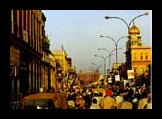 CHANDNI CHOWK : The colourful
shopping bazaar known as Chandni Chowk is the main street of Old
Delhi. The Sunheri Masjid stands next to the Kotwali (old police
station). On the roof of this very mosque, in 1739, Nadir Shah,
the Persian invader who carried off the Peacock Throne when he
ransacked Delhi, stood watched while his soldiers conducted a
bloody massacre. The Fatehpuri Mosque, erected in 1650 by one of
Shah Jahan's wives, stands at the west end of Chandni Chowk.
CHANDNI CHOWK : The colourful
shopping bazaar known as Chandni Chowk is the main street of Old
Delhi. The Sunheri Masjid stands next to the Kotwali (old police
station). On the roof of this very mosque, in 1739, Nadir Shah,
the Persian invader who carried off the Peacock Throne when he
ransacked Delhi, stood watched while his soldiers conducted a
bloody massacre. The Fatehpuri Mosque, erected in 1650 by one of
Shah Jahan's wives, stands at the west end of Chandni Chowk.
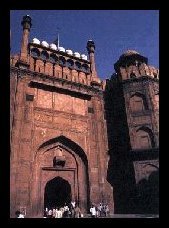 RED FORT : The
red sandstone walls of Lal Qila, the Red Fort, extend for two km
and vary in height from 18 metres on the river side to 33 metres
on the city side. Shah Jahan started construction of the massive
fort in 1638 and it was completed in 1648. Before he could move
his capital from Agra to Shahjahanabad in Delhi, he was deposed
and imprisoned in Agra Fort by his son Aurangzeb. Entry to the
fort is Rs 0.50; free on Friday.
RED FORT : The
red sandstone walls of Lal Qila, the Red Fort, extend for two km
and vary in height from 18 metres on the river side to 33 metres
on the city side. Shah Jahan started construction of the massive
fort in 1638 and it was completed in 1648. Before he could move
his capital from Agra to Shahjahanabad in Delhi, he was deposed
and imprisoned in Agra Fort by his son Aurangzeb. Entry to the
fort is Rs 0.50; free on Friday.
UP
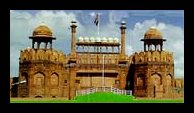 LAHORE GATE : The
Lahore gate, the main gate to the fort, gets its name from the
fact that it faces towards Lahore, now in Pakistan. It leads to a
vaulted arcade, the Chatta Chowk (Covered Bazaar). The shops
cater to the tourist trade today, but once they stocked articles
for royal households - silks, jewellery, gold. This arcade was
also known as the Meena Bazaar, were ladies of the court shopped.
On Thursdays, men were barred from entering the fort and only
women were allowed inside the citadel. The arcade leads to the
Naubat Khana, or Drum House, where musicians used to play for the
emperor, and the arrival of princes and royalty was heralded from
here.
LAHORE GATE : The
Lahore gate, the main gate to the fort, gets its name from the
fact that it faces towards Lahore, now in Pakistan. It leads to a
vaulted arcade, the Chatta Chowk (Covered Bazaar). The shops
cater to the tourist trade today, but once they stocked articles
for royal households - silks, jewellery, gold. This arcade was
also known as the Meena Bazaar, were ladies of the court shopped.
On Thursdays, men were barred from entering the fort and only
women were allowed inside the citadel. The arcade leads to the
Naubat Khana, or Drum House, where musicians used to play for the
emperor, and the arrival of princes and royalty was heralded from
here.
 DIWAN-I-AAM :
The Hall of Public Audiences. Here, in a marble-panelled alcove,
set with precious stones, the emperor would sit to hear
complaints or disputes from his subjects. It was badly looted in
the mutiny. This elegant hall was restored as a result of a
directive by Lord Curzon, the viceroy of India between 1898 and
1905.
DIWAN-I-AAM :
The Hall of Public Audiences. Here, in a marble-panelled alcove,
set with precious stones, the emperor would sit to hear
complaints or disputes from his subjects. It was badly looted in
the mutiny. This elegant hall was restored as a result of a
directive by Lord Curzon, the viceroy of India between 1898 and
1905.
DIWAN-I-KHAS :
The Hall of Private Audiences; Here, in this luxurious chamber
built of white marble, the emperor would hold private meetings.
Centerpiece of the hall (until Nadir Shah carted it off to Iran
in 1739) was the magnificent Peacock Throne.
UP
ROYAL BATHS :
The Hammams or baths - were large rooms surmounted by domes, with
fountains in the centre - one of which was set up as a sauna !
The floors used to be inlaid with pietra dura work, and the rooms
were illuminated through panels of coloured glass in the roof.
The baths are now, closed to the public. Shahi Burj, a
three-storey octagonal tower at the north-eastern edge of the
fort, was once Shah Jahan's private working area. Moti Masjid,
built in 1659 by Aurangzeb for his own personal use is a small
and totally enclosed Pearl Mosque, made of marble, next to the
baths. A very interesting feature of the mosque is that while its
outer walls are oriented to be in symmetry with the rest of the
fort, the inner walls are slightly askew, so that the mosque has
the correct orientation with Mecca.
OTHER FEATURES :
The Khas Mahal, standing to the south of the Diwan-i-Khas, was
the emperor's private palace, It had rooms for worship, sleeping
and living . Further south stands the Rang Mahal or Palace of
Colour, so-called because of its painted interior, which is now
gone. This was the residence of the emperor's chief wife, and
this was also where he ate. The floor in the centre has a
beautifully carved marble lotus, and the water flowing along the
channel from the Shahi Burj used to end up here. Originally a
fountain made of ivory stood in the centre. Still further south
along the eastern wall is a small Museum of Archaeology in the
Mumtaz Mahal, which is well worth a look. In between all these
exquisite buildings were the highly formal Charbagh gardens,
complete with fountains, pools and small pavilions. While the
general outline and some of the pavilion are still in place, the
gardens are not what they once were.
UP
SOUND &
LIGHT SHOW : An event of Indian history,
particularly those connected with the Red Fort is re-created each
evening through the interesting sound & light show. Shows are
in English and Hindi, and tickets (Rs 20) are available from the
fort. The English session are at 7.30 pm from November through
January, 8.30 pm from February to April had September-October,
and at 9 pm from May to August. It's well worth making the effort
to see this show.
UP
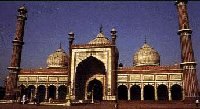 JAMA MASJID :
The great mosque of Old Delhi is both the largest in India and
the Final architectural extravagance of Shah Jahan. Commenced in
1644 , the mosque was not completed until 1658. It has three
great gateways, four angle towers and two minarets standing 40
meters high and constructed of alternating vertical strips of red
sandstone and white marble. There's a Rs 15 fee to take a camera
inside to mosque, and another Rs 15 to take it up the minaret.
JAMA MASJID :
The great mosque of Old Delhi is both the largest in India and
the Final architectural extravagance of Shah Jahan. Commenced in
1644 , the mosque was not completed until 1658. It has three
great gateways, four angle towers and two minarets standing 40
meters high and constructed of alternating vertical strips of red
sandstone and white marble. There's a Rs 15 fee to take a camera
inside to mosque, and another Rs 15 to take it up the minaret.
CORONATION
DURBAR SITE : This is a must for
incurable Raj fans looking for their fix of nostalgia. It's north
of Old Delhi and is best reached by auto-rickshaw. An obelisk
marks the site where the durbars were enacted between 1877 and
1903. It was also here in 1911 that King George V was declared
emperor of India.
FEROZ SHAH KOTLA :
The ruins of Ferozabad, the
fifth city of Delhi, erected by Feroz Shah Tughlaq in 1354 can be
found at Feroz Shah Kotla, just off Bahadur Shah Zafar Marg
between the Old and New Delhi. A 13-metre-high sandstone Ashoka's
edicts (and a later inscription) can be seen in the old fortress
palace. Also to be seen are the remains of an old mosque and a
fine well. But most of the ruins have been used for construction
of later cities.
RAJ GHAT :
A simple square platform of black marble north-east of Feroz Shah
Kotla, on the banks of the Yamuna, marks the spot where Mahatma
Gandhi was cremated following his assassination in 1948. A
commemorative ceremony is held every Friday, the day he was
killed. Just to the north of Raj Ghat, at Shanti Van, Jawaharlal
Nehru, the first Indian Prime minister, was cremated in1964. His
daughter, Indira Gandhi, who was killed in 1984, and grandsons
Sanjoy (1980) and Rajiv (1991) were also cremated in this
vicinity. The Raj Ghat area is now a beautiful park, complete
with labelled trees planted by a mixed bag of notables including
Queen Elizabeth II , Gough Whitlam, Dwight Eisenhower and Ho Chi
Minh !
UP
 PURANA QUILA :
Purana Qila is the supposed site of Indraprastha, the original
city of Delhi. The Afghan ruler, Sher Shah, who briefly
interrupted the Mughal Empire by defeating Humayun, completed the
fort during his reign from 1538-45, before Humayun regained
control of India. The fort, located south-east of the India Gate
and north of Humayun's Tomb and the Nizamuddin railway station,
has massive walls and three large gateways. There is a small
octagonal red sandstone tower, the Sher Mandal, in side the fort
near the South gate. It was later used by Humayun as a library.
While descending the stairs of this tower one day in 1556, he
slipped, fell and received injuries from which he later died. The
Qila-i-Kuhran Mosque, or Mosque of Sher Shah, lies just beyond it
and unlike the fort itself, is in a fairly reasonable condition.
There's a small archaeological museum just inside the main gate.
There are good views of New Delhi from atop the gate.
PURANA QUILA :
Purana Qila is the supposed site of Indraprastha, the original
city of Delhi. The Afghan ruler, Sher Shah, who briefly
interrupted the Mughal Empire by defeating Humayun, completed the
fort during his reign from 1538-45, before Humayun regained
control of India. The fort, located south-east of the India Gate
and north of Humayun's Tomb and the Nizamuddin railway station,
has massive walls and three large gateways. There is a small
octagonal red sandstone tower, the Sher Mandal, in side the fort
near the South gate. It was later used by Humayun as a library.
While descending the stairs of this tower one day in 1556, he
slipped, fell and received injuries from which he later died. The
Qila-i-Kuhran Mosque, or Mosque of Sher Shah, lies just beyond it
and unlike the fort itself, is in a fairly reasonable condition.
There's a small archaeological museum just inside the main gate.
There are good views of New Delhi from atop the gate.
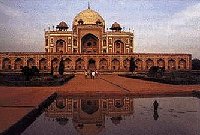 HUMAYUN'S TOMB :
The tomb is an early example of Mughal architecture. Humayun's
senior wife Haji Begum had it built in the mid-16th century. This
earlier tomb is thus of great interest for its relation to the
later Taj. The squat building, lighted by high arched entrances,
topped by a bulbous dome and surrounded by formal gardens - were
to be refined over the years to the magnificence of the Taj Mahal
in Agra. Haji Begum too is buried in the tomb. The garden has
other tombs including that of Humayun's barber and the Tomb of
Isa Khan. The latter is a good example of Lodi architecture.
Entry is free on friday. On other days, there is a small entry
fee. There is an excellent view of the surrounding countru from
the terraces of the tomb.
HUMAYUN'S TOMB :
The tomb is an early example of Mughal architecture. Humayun's
senior wife Haji Begum had it built in the mid-16th century. This
earlier tomb is thus of great interest for its relation to the
later Taj. The squat building, lighted by high arched entrances,
topped by a bulbous dome and surrounded by formal gardens - were
to be refined over the years to the magnificence of the Taj Mahal
in Agra. Haji Begum too is buried in the tomb. The garden has
other tombs including that of Humayun's barber and the Tomb of
Isa Khan. The latter is a good example of Lodi architecture.
Entry is free on friday. On other days, there is a small entry
fee. There is an excellent view of the surrounding countru from
the terraces of the tomb.
UP
NIZAMUDDIN
: The shrine of the Muslim Sufi saint,
Nizamud-din Chishti, who died in 1325 aged 92, is across the road
from Humayun's tomb. With its large tank, it is one of several
interesting tombs here. Other tombs include the later grave of
Jahanara, the daughter of Shan Jahan, who stayed with her father
during his imprisonment by Aurangzeb in Agra's Red Fort. Amir
Khusru, a renowned Urdu poet, also has his tomb here as does
Atgah Khan, a favourite of Humayun and his son Akbar. It's worth
visiting the shrine at around sunset on Thursdays, as it is a
popular time for worship, and qawwali singers start performing
after the evening prayers.
LODI GARDENS :
Adjoining the India International Centre are The Lodi Gardens.
These well-kept gardens contain the tombs of the Sayyid and Lodi
rulers. Mohammed Shah's Tomb (1450) was a prototype for the later
Mughal-style tomb of Humayun, a design which would eventually
develop into the Taj Mahal. Other tombs include those of his
predecessor Mubarak Shah (1433), Ibrahim Lodi (1526) and Sikander
Lodi (1517). The Bara Gumbad Mosque is a fine example of its type
of plaster decoration.
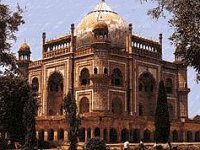 SAFDARJANG TOMB :
The Safdarjang Tomb was built in 1753-54 by the Nawab of Avadh
for his father, Safdarjang, and is one of the last examples of
Mughal architecture before the final remnants of the great empire
collapsed. The tomb stands on a high terrace in an extensive
garden. Entry is free on Friday. On other day a small entry fee
is charged. This Tomb is adjacent to the small Safdarjung
airport.
SAFDARJANG TOMB :
The Safdarjang Tomb was built in 1753-54 by the Nawab of Avadh
for his father, Safdarjang, and is one of the last examples of
Mughal architecture before the final remnants of the great empire
collapsed. The tomb stands on a high terrace in an extensive
garden. Entry is free on Friday. On other day a small entry fee
is charged. This Tomb is adjacent to the small Safdarjung
airport.
HAUZ KHAS :
Lying midway between Safdarjang and the Qutab Minar, this area
was once the reservoir for the second city of Delhi, Siri. Feroz
Shah's Tomb (1398) and the remains of an ancient college can be
seen here. It was around this area that Timur defeated the forces
of Mohammed Shah Tughlaq in 1398. Also part of the old city of
Siri is the Moth ki Masjid, which lies some distance to the east
of Hauz Khas, the finest in the Lodi style.
UP
KHIRKI MASJID
& JAHANPANAH : This mosque dating
from 1380 has four open courts. The nearby village of Khirki also
takes its name from the mosque. The remains of the fourth city of
Delhi, Jahanpanah, lie closeby. Also found close by are the high
Bijai Mandal platform and the Begumpur Mosque with its
multiplicity of domes.
TUGHLAQABAD:
The walled city and fort of Tughlaqabad with its 13 gateways the
third city of Delhi, are east of the Qutab Minar. It was built by
Ghiyas-ud-din Tughlaq and its construction involved a legendary
quarrel with the saint Nizam-ud-din, when the Tughlaq ruler took
the workers whom Nizam-ud-din wanted for work on his shrine.
UP
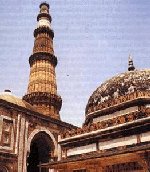 QUTAB MINAR COMPLEX :
The buildings in this complex, in South Delhi, date from the
onset of Muslim rule in India. The Qutab Minar itself is a
soaring tower of victory which was started in 1193, immediately
after the defeat of the last Hindu Kingdom in Delhi. It is nearly
73 meters high and tapers from a 15-meter-diameter base to just
2.5 meters at the top. The tower has five distinct storeys, each
marked by a projecting balcony. The first three storeys are made
or red sandstone, the fourth and fifth of marble of sandstone.
Although Qutab-ud-din began construction of the tower, he only
got to the first storey. His successors completed it and, in
1368, Feroz Shah Tughlaq rebuilt the top storeys and added a
cupola. An earthquake brought the cupola down in 1803 and an
Englishman replaced it with another in 1829. However, that dome
was removed some years later. Today , this impressively ornate
tower has a slight tilt, but otherwise has worn the centuries
remarkably well. The tower is closed to visitors.
QUTAB MINAR COMPLEX :
The buildings in this complex, in South Delhi, date from the
onset of Muslim rule in India. The Qutab Minar itself is a
soaring tower of victory which was started in 1193, immediately
after the defeat of the last Hindu Kingdom in Delhi. It is nearly
73 meters high and tapers from a 15-meter-diameter base to just
2.5 meters at the top. The tower has five distinct storeys, each
marked by a projecting balcony. The first three storeys are made
or red sandstone, the fourth and fifth of marble of sandstone.
Although Qutab-ud-din began construction of the tower, he only
got to the first storey. His successors completed it and, in
1368, Feroz Shah Tughlaq rebuilt the top storeys and added a
cupola. An earthquake brought the cupola down in 1803 and an
Englishman replaced it with another in 1829. However, that dome
was removed some years later. Today , this impressively ornate
tower has a slight tilt, but otherwise has worn the centuries
remarkably well. The tower is closed to visitors.
QUWWAT-ISLAM
MASJID : The Might of Islam Mosque, at
the foot of the Qutab Minar was the first mosque to be built in
India. Qutab-ud-din began construction of the mosque in 1193, but
it has had a number of additions and extensions over the
centuries . The original mosque was built on the foundations of a
Hindu temple. Many of the elements in the mosque's construction
indicate their Hindu or Jain origins. Altamish, Qutab-ud-din's
son-in-law, built a cloistered court around the original small
mosque in 1210-20. Ala-ud-din added a court to the east and the
magnificent Alai Darwaza gateway in 1300.
UP
IRON PILLAR :
This seven-metre-high pillar stands in the courtyard of the
mosque and has been there since long before the mosque's
construction. A six - line Sanskrit inscription indicates that it
was initially erected outside a Vishnu temple, possibly in Bihar,
and was raised in memory of the Gupta King Chandragupta
Vikramaditya, who ruled from 375 to 413. What the inscription
does not tell is how it was made, for the iron in the pillar is
of quite exceptional purity. Scientists have never discovered how
this iron, which is of such purity that it has not rusted after
2000 years, could be cast with the technology of the time. It is
said that if you can encircle the pillar with your hands whilst
standing with your back to it, your wish will be fulfilled.
ALAI MINAR :
At the same time Ala-ud-din made his additions to the mosque, he
also conceived a far more ambitious construction programme. He
would build a second tower of victory, exactly like the Qutab
Minar, except it would be twice as high! When he died the tower
had reached 27 metres and no-one was willing to continue his
overambitious project. The uncompleted tower stands to the north
of the Qutab Minar and the mosque. Other features: Ala-ud-din's
Alai Darwaza gateway is the main entrance to the whole complex.,
It was built of red sandstone in 1310 and stands just south-west
of the Qutab Minar. The tomb of Imam Zamin stands beside the
gateway, while the tomb of Altamish, who died in 1235, is by the
north - west corner of the mosque. A short distance west of the
enclosure, in Mehrauli village, is the Tomb of Adham Khan who,
amongst other things, according to legend drove the beautiful
Hindu singer Rupmati to suicide following the capture of Mandu
(see Mandu in the Madhya Pradesh chapter). When Akbar became
displeased with him he ended up being heaved off a terrace in the
Agra Fort. There are some summer palaces in the area and also the
tombs of the last kings of Delhi, who succeeded the last Mughals.
An empty space between two of the tombs was intended for the last
king of Delhi, who died in exile in Rangoon, Burma (Myanmar), in
1862, following his implication in the 1857 Indian Mutiny.
UP
 CONNAUGHT PLACE :
Connaught Place is a vast traffic circle with an architecturally
uniform series of colonnaded buildings around the edge - mainly
devoted to shops, banks, restaurants, airline offices and the
like. Located at the northern end of New Delhi, it is a busy
business and tourist centre.
CONNAUGHT PLACE :
Connaught Place is a vast traffic circle with an architecturally
uniform series of colonnaded buildings around the edge - mainly
devoted to shops, banks, restaurants, airline offices and the
like. Located at the northern end of New Delhi, it is a busy
business and tourist centre.
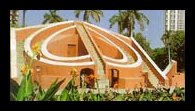 JANTAR MANTAR :
Built in 1725 by Maharaja Jai Singh II of Jaipur, a keen
astronomer, this observatory is dominated by a huge sundial known
as the Prince of Dials. Other instruments plots the course of
heavenly bodies and predicts eclipses. This massive salmon
coloured Jantar Mantar is only a short stroll down Sansad Marg
(parliament street).
JANTAR MANTAR :
Built in 1725 by Maharaja Jai Singh II of Jaipur, a keen
astronomer, this observatory is dominated by a huge sundial known
as the Prince of Dials. Other instruments plots the course of
heavenly bodies and predicts eclipses. This massive salmon
coloured Jantar Mantar is only a short stroll down Sansad Marg
(parliament street).
LAKSHMI
NARAYAN TEMPLE : The temple erected by
industrialist B D Birla in 1938 is dedicated to Lakshmi, the
goddess of prosperity and good fortune, and is commonly known as
Birla Mandir.
RAJPATH :
The immensely broad Rajpath or Kings way is where the Repbulic
Day parade is held every January 26. Flanked on either side by
ornamental ponds, the Rajpath is another focus of Lutyens' New
Delhi.
 INDIA GATE : At
the eastern end of the Rajpath, stands this 42-metre-high stone
arch of. On it are inscribed the name of 85,000 Indian Army
soldiers who died in the campaigns of WW I, the North-West
Frontier operations of the same time and the 1919 Afghan fiasco.
INDIA GATE : At
the eastern end of the Rajpath, stands this 42-metre-high stone
arch of. On it are inscribed the name of 85,000 Indian Army
soldiers who died in the campaigns of WW I, the North-West
Frontier operations of the same time and the 1919 Afghan fiasco.
UP
SECRETARIAT
BUILDING : On either side of Rajpath on
Raisina hill, lie the imposing North and South Secretariat
Buildings topped with chhatris (small domes). They now house the
ministries of the Finance and External Affairs respectively.
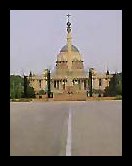 RASHTRAPATI BHAVAN :
At the opposite end of the Rajpath from India Gate stands the
official residence of the President of India. The palace-like
building, completed in 1929, is a blend of Mughal and Western
architectural styles, the most obvious Indian feature being the
huge copper dome. The Mughal garden to the west of the building
occupies 130 hectares. It is open to the public in February.
RASHTRAPATI BHAVAN :
At the opposite end of the Rajpath from India Gate stands the
official residence of the President of India. The palace-like
building, completed in 1929, is a blend of Mughal and Western
architectural styles, the most obvious Indian feature being the
huge copper dome. The Mughal garden to the west of the building
occupies 130 hectares. It is open to the public in February.
SANSAD BHAVAN :
The circular colonnaded Indian parliament building, stands almost
hidden and virtually unnoticed at the end of Sansad Marg, or
Parliament St, just north of Rajpath. Permits to visit the
parliament and sit in the public gallery are available from the
reception office on Raisina Road. Tourists will need a letter of
introduction from their embassies.
THE DELHI ZOO :
The Delhi Zoo is on the south side of the Purana Qila. There are
a number of white tigers though. The zoo is open daily except
Friday, in summer from 8 am to 6 pm and in winter from 9 am to 5
pm. There is a small entry fee.
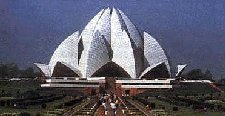 BAHAI TEMPLE :
The lotus shaped Bahai temple lies to the east of Siri. Set
amongst pools and gardens, adherents of any faith are free to
visit the temple and parry or meditate silently according to
their own religion. It looks particularly spectacular at dusk
when it is floodlit. The temple is open to visitors from April to
September, daily except Monday from 9 am, to 7 pm. and October to
March from 9.30 am. to 5.30 pm.
BAHAI TEMPLE :
The lotus shaped Bahai temple lies to the east of Siri. Set
amongst pools and gardens, adherents of any faith are free to
visit the temple and parry or meditate silently according to
their own religion. It looks particularly spectacular at dusk
when it is floodlit. The temple is open to visitors from April to
September, daily except Monday from 9 am, to 7 pm. and October to
March from 9.30 am. to 5.30 pm.
UP
[General Information] [Tourist Information] [Places of Interest] [Nightlife] [Eating Out] [Cinemas]
[Art Galleries] [Auditoria] [Museums] [Libraries/Cultural] [Centres] [Hotels/Apartments]
[Recreation] [Cyber Cafes] [Shopping Areas] [Tourist Offices]
[Embassies] [International Airlines] [Domestic Airlines] [Car
Rentals] [Travel Agents] [Hospitals] [24-hour Chemists] [24-hour
Petrol Pumps] [Major Banks]
BACK TO MAIN PAGE


 RED FORT : The
red sandstone walls of Lal Qila, the Red Fort, extend for two km
and vary in height from 18 metres on the river side to 33 metres
on the city side. Shah Jahan started construction of the massive
fort in 1638 and it was completed in 1648. Before he could move
his capital from Agra to Shahjahanabad in Delhi, he was deposed
and imprisoned in Agra Fort by his son Aurangzeb. Entry to the
fort is Rs 0.50; free on Friday.
RED FORT : The
red sandstone walls of Lal Qila, the Red Fort, extend for two km
and vary in height from 18 metres on the river side to 33 metres
on the city side. Shah Jahan started construction of the massive
fort in 1638 and it was completed in 1648. Before he could move
his capital from Agra to Shahjahanabad in Delhi, he was deposed
and imprisoned in Agra Fort by his son Aurangzeb. Entry to the
fort is Rs 0.50; free on Friday.  LAHORE GATE : The
Lahore gate, the main gate to the fort, gets its name from the
fact that it faces towards Lahore, now in Pakistan. It leads to a
vaulted arcade, the Chatta Chowk (Covered Bazaar). The shops
cater to the tourist trade today, but once they stocked articles
for royal households - silks, jewellery, gold. This arcade was
also known as the Meena Bazaar, were ladies of the court shopped.
On Thursdays, men were barred from entering the fort and only
women were allowed inside the citadel. The arcade leads to the
Naubat Khana, or Drum House, where musicians used to play for the
emperor, and the arrival of princes and royalty was heralded from
here.
LAHORE GATE : The
Lahore gate, the main gate to the fort, gets its name from the
fact that it faces towards Lahore, now in Pakistan. It leads to a
vaulted arcade, the Chatta Chowk (Covered Bazaar). The shops
cater to the tourist trade today, but once they stocked articles
for royal households - silks, jewellery, gold. This arcade was
also known as the Meena Bazaar, were ladies of the court shopped.
On Thursdays, men were barred from entering the fort and only
women were allowed inside the citadel. The arcade leads to the
Naubat Khana, or Drum House, where musicians used to play for the
emperor, and the arrival of princes and royalty was heralded from
here.  DIWAN-I-AAM :
The Hall of Public Audiences. Here, in a marble-panelled alcove,
set with precious stones, the emperor would sit to hear
complaints or disputes from his subjects. It was badly looted in
the mutiny. This elegant hall was restored as a result of a
directive by Lord Curzon, the viceroy of India between 1898 and
1905.
DIWAN-I-AAM :
The Hall of Public Audiences. Here, in a marble-panelled alcove,
set with precious stones, the emperor would sit to hear
complaints or disputes from his subjects. It was badly looted in
the mutiny. This elegant hall was restored as a result of a
directive by Lord Curzon, the viceroy of India between 1898 and
1905.  JAMA MASJID :
The great mosque of Old Delhi is both the largest in India and
the Final architectural extravagance of Shah Jahan. Commenced in
1644 , the mosque was not completed until 1658. It has three
great gateways, four angle towers and two minarets standing 40
meters high and constructed of alternating vertical strips of red
sandstone and white marble. There's a Rs 15 fee to take a camera
inside to mosque, and another Rs 15 to take it up the minaret.
JAMA MASJID :
The great mosque of Old Delhi is both the largest in India and
the Final architectural extravagance of Shah Jahan. Commenced in
1644 , the mosque was not completed until 1658. It has three
great gateways, four angle towers and two minarets standing 40
meters high and constructed of alternating vertical strips of red
sandstone and white marble. There's a Rs 15 fee to take a camera
inside to mosque, and another Rs 15 to take it up the minaret.  PURANA QUILA :
Purana Qila is the supposed site of Indraprastha, the original
city of Delhi. The Afghan ruler, Sher Shah, who briefly
interrupted the Mughal Empire by defeating Humayun, completed the
fort during his reign from 1538-45, before Humayun regained
control of India. The fort, located south-east of the India Gate
and north of Humayun's Tomb and the Nizamuddin railway station,
has massive walls and three large gateways. There is a small
octagonal red sandstone tower, the Sher Mandal, in side the fort
near the South gate. It was later used by Humayun as a library.
While descending the stairs of this tower one day in 1556, he
slipped, fell and received injuries from which he later died. The
Qila-i-Kuhran Mosque, or Mosque of Sher Shah, lies just beyond it
and unlike the fort itself, is in a fairly reasonable condition.
There's a small archaeological museum just inside the main gate.
There are good views of New Delhi from atop the gate.
PURANA QUILA :
Purana Qila is the supposed site of Indraprastha, the original
city of Delhi. The Afghan ruler, Sher Shah, who briefly
interrupted the Mughal Empire by defeating Humayun, completed the
fort during his reign from 1538-45, before Humayun regained
control of India. The fort, located south-east of the India Gate
and north of Humayun's Tomb and the Nizamuddin railway station,
has massive walls and three large gateways. There is a small
octagonal red sandstone tower, the Sher Mandal, in side the fort
near the South gate. It was later used by Humayun as a library.
While descending the stairs of this tower one day in 1556, he
slipped, fell and received injuries from which he later died. The
Qila-i-Kuhran Mosque, or Mosque of Sher Shah, lies just beyond it
and unlike the fort itself, is in a fairly reasonable condition.
There's a small archaeological museum just inside the main gate.
There are good views of New Delhi from atop the gate.  HUMAYUN'S TOMB :
The tomb is an early example of Mughal architecture. Humayun's
senior wife Haji Begum had it built in the mid-16th century. This
earlier tomb is thus of great interest for its relation to the
later Taj. The squat building, lighted by high arched entrances,
topped by a bulbous dome and surrounded by formal gardens - were
to be refined over the years to the magnificence of the Taj Mahal
in Agra. Haji Begum too is buried in the tomb. The garden has
other tombs including that of Humayun's barber and the Tomb of
Isa Khan. The latter is a good example of Lodi architecture.
Entry is free on friday. On other days, there is a small entry
fee. There is an excellent view of the surrounding countru from
the terraces of the tomb.
HUMAYUN'S TOMB :
The tomb is an early example of Mughal architecture. Humayun's
senior wife Haji Begum had it built in the mid-16th century. This
earlier tomb is thus of great interest for its relation to the
later Taj. The squat building, lighted by high arched entrances,
topped by a bulbous dome and surrounded by formal gardens - were
to be refined over the years to the magnificence of the Taj Mahal
in Agra. Haji Begum too is buried in the tomb. The garden has
other tombs including that of Humayun's barber and the Tomb of
Isa Khan. The latter is a good example of Lodi architecture.
Entry is free on friday. On other days, there is a small entry
fee. There is an excellent view of the surrounding countru from
the terraces of the tomb.  SAFDARJANG TOMB :
The Safdarjang Tomb was built in 1753-54 by the Nawab of Avadh
for his father, Safdarjang, and is one of the last examples of
Mughal architecture before the final remnants of the great empire
collapsed. The tomb stands on a high terrace in an extensive
garden. Entry is free on Friday. On other day a small entry fee
is charged. This Tomb is adjacent to the small Safdarjung
airport.
SAFDARJANG TOMB :
The Safdarjang Tomb was built in 1753-54 by the Nawab of Avadh
for his father, Safdarjang, and is one of the last examples of
Mughal architecture before the final remnants of the great empire
collapsed. The tomb stands on a high terrace in an extensive
garden. Entry is free on Friday. On other day a small entry fee
is charged. This Tomb is adjacent to the small Safdarjung
airport.  JANTAR MANTAR :
Built in 1725 by Maharaja Jai Singh II of Jaipur, a keen
astronomer, this observatory is dominated by a huge sundial known
as the Prince of Dials. Other instruments plots the course of
heavenly bodies and predicts eclipses. This massive salmon
coloured Jantar Mantar is only a short stroll down Sansad Marg
(parliament street).
JANTAR MANTAR :
Built in 1725 by Maharaja Jai Singh II of Jaipur, a keen
astronomer, this observatory is dominated by a huge sundial known
as the Prince of Dials. Other instruments plots the course of
heavenly bodies and predicts eclipses. This massive salmon
coloured Jantar Mantar is only a short stroll down Sansad Marg
(parliament street).  INDIA GATE : At
the eastern end of the Rajpath, stands this 42-metre-high stone
arch of. On it are inscribed the name of 85,000 Indian Army
soldiers who died in the campaigns of WW I, the North-West
Frontier operations of the same time and the 1919 Afghan fiasco.
INDIA GATE : At
the eastern end of the Rajpath, stands this 42-metre-high stone
arch of. On it are inscribed the name of 85,000 Indian Army
soldiers who died in the campaigns of WW I, the North-West
Frontier operations of the same time and the 1919 Afghan fiasco. RASHTRAPATI BHAVAN :
At the opposite end of the Rajpath from India Gate stands the
official residence of the President of India. The palace-like
building, completed in 1929, is a blend of Mughal and Western
architectural styles, the most obvious Indian feature being the
huge copper dome. The Mughal garden to the west of the building
occupies 130 hectares. It is open to the public in February.
RASHTRAPATI BHAVAN :
At the opposite end of the Rajpath from India Gate stands the
official residence of the President of India. The palace-like
building, completed in 1929, is a blend of Mughal and Western
architectural styles, the most obvious Indian feature being the
huge copper dome. The Mughal garden to the west of the building
occupies 130 hectares. It is open to the public in February.  BAHAI TEMPLE :
The lotus shaped Bahai temple lies to the east of Siri. Set
amongst pools and gardens, adherents of any faith are free to
visit the temple and parry or meditate silently according to
their own religion. It looks particularly spectacular at dusk
when it is floodlit. The temple is open to visitors from April to
September, daily except Monday from 9 am, to 7 pm. and October to
March from 9.30 am. to 5.30 pm.
BAHAI TEMPLE :
The lotus shaped Bahai temple lies to the east of Siri. Set
amongst pools and gardens, adherents of any faith are free to
visit the temple and parry or meditate silently according to
their own religion. It looks particularly spectacular at dusk
when it is floodlit. The temple is open to visitors from April to
September, daily except Monday from 9 am, to 7 pm. and October to
March from 9.30 am. to 5.30 pm.